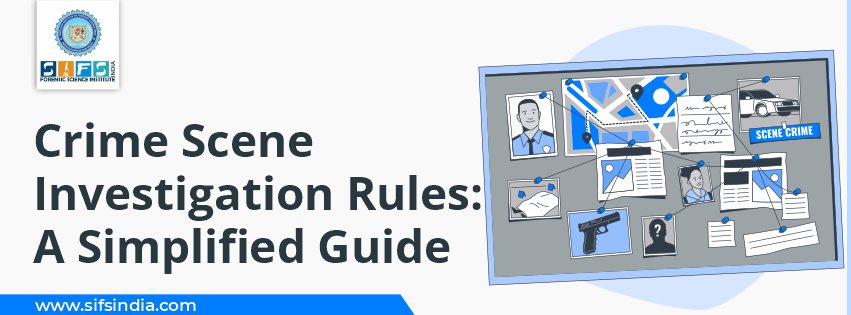- Call Us: +91 7303913002
- Email Us: education@sifs.in
Crime Scene Investigation Rules: A Simplified Guide

BY SIFS India | July 20, 2022
Crime Scene Investigation Rules: A Simplified Guide
No two crime scenes are alike. Some might be outdoors, some indoors, and some virtual. Depending on the crime scene, investigators must devise a specific investigation strategy for that crime.
As all crimes differ, one investigating strategy cannot work for all.
However, there are a few basic steps that crime scene investigators adopt every time during the crime scene investigation.
Let us discuss crime scene investigation rules in detail.
Securing the Scene to Protect Evidence
It is the first and the most crucial step. The lead officer arriving at the scene isolates the area to protect the evidence.
The focal point and the area radiating from this point and much larger than the crime scene are secured using a crime scene tape. A larger area is secured to ensure no relevant evidence is left behind.
The forensic investigators might condense the scene later.
If this is not done, potential evidence might be left outside the scene that might get damaged by the spectators. At this stage, scene’s safety is the top priority. Sometimes people who are suspected to be involved in crime are also arrested.
Separating the Witnesses to Establish Security
As per Locard’s principle of exchange, whenever two items come into contact with each other, they will exchange material.
Hence, it is essential to secure the area as soon as possible.
All the witnesses are separated, and the primary reason is to prevent them from indulging in conversations and sharing details about the crime.
Also, a common entry and exit way is created for investigating officers to use. Once the scene is secured, any person who enters or leaves the area is documented.
Creating a Plan for Crime Scene Investigation
The investigating officers determine the type of crime, look for threats, like weather to the evidence, make a list of resources required, and do crime scene scanning to get the entire picture of the crime scene.
It helps them identify where the crime occurred, the types of evidence that might be present, and other secondary or crime-related areas.
They also talk with witnesses before creating an evidence collection strategy and consider various factors like weather conditions and the time of the day.
Finally, they carry out conversations with their team to plan how to proceed.
Conducting Primary Survey & Photographing the Scene
An initial crime scene survey is conducted under the supervision of the lead investigator.
It involves identifying valuable evidence, taking notes, and photographing the scene and evidence.
The crime scene photographer clicks pictures of the entire area and takes close-up images of the objects from different angles. It is done by placing evidence markers and rulers for size reference.
A sketch of the crime scene is also created to help the investigating officers to recreate the scene at a different location if required.
The sketch includes all the objects present, evidence’s location, direction, date, time, and case number.
Complete documentation of the crime scene is done to record the position of the objects present, the smell in the surroundings, the temperature of the area, etc.
Documenting and Processing the Scene
A proper procedure is followed to process the crime scene. With the plan in hand, the forensic team conducts an in-depth crime scene investigation and collects all the evidence properly to ensure none is damaged or contaminated.
It involves documentation using digital and video cameras and sometimes 3D scanners also. Sketches, if needed, are also created. Complete
The evidence collection process involves collecting, packaging, and preserving and needs special attention if the evidence is biological.
So, a proper procedure with complete documentation of each step and evidence collected is done.
Conducting Second Survey
A thorough secondary search is conducted to ensure everything is processed, all details are recorded, and to identify any evidence that might have been overlooked.
The lead investigator carries out this search and can occur in several patterns.
Securing & Recording the Evidence
All the evidence is identified, collected, and secured using specific procedures and techniques to avoid spoilage.
Evidence is marked with a label, and a detailed description is noted in an inventory log.
It should match the photograph taken from the crime scene and the description recorded in the crime scene report.
It helps establish the chain of custody throughout the lifecycle of the crime scene investigation. It means all the investigation steps are recorded in chronological order in which they are carried out.
Final Words
After learning about crime scene investigation rules, you must have realized that becoming a crime scene investigator is not rocket science. With the proper guidance and education, you can fulfill your dream.
Sherlock Institute of Forensic Science offers a basic to advanced certified forensic crime scene investigator course, a perfect blend of theory and practical knowledge. The course aims to create job-ready crime scene investigators to help law enforcement agencies carry out investigation processes effectively and create a crime-free society.
